Camorra: myths and reality
Previous articles have covered the Sicilian Mafia and Cosa Nostra, "families" operating in the United States. Now we will talk about criminal communities in other regions of Italy.
In this article, we will briefly talk about stories the emergence of the Neapolitan (Campanian) Camorra. The next ones will talk about the new structures of the Camorra, about the women of the Camorra and the emergence of the Sacra Corona Unita. And then let's talk about the Calabrian Ndrangheta.
We must say right away that in Italy itself there is a distinction between the mafia and
(This is the official term used by Italian lawyers).
Mafia is inextricably linked with Sicily, and the "mafia-type organizations" include the criminal communities of Campania, Puglia and Calabria.
According to information provided to reporters by the FBI, there are currently about 25 thousand people in the above-listed criminal communities in Italy who have connections with criminals in other countries of the world, the number of which reaches 250 thousand. At the same time, the "new" American Cosa Nostra is already weakly connected with the Sicilian mafia and is an independent criminal organization focused mainly on the drug trade.
Neapolitan Camorra
The birthplace of the Camorra is the province of Campania, whose name derives from the Latin word campus - "plain". The map below shows that only the coastal areas of the modern province of Campania are flat. The mountains, however, are not high here - the highest point is 2050 meters.
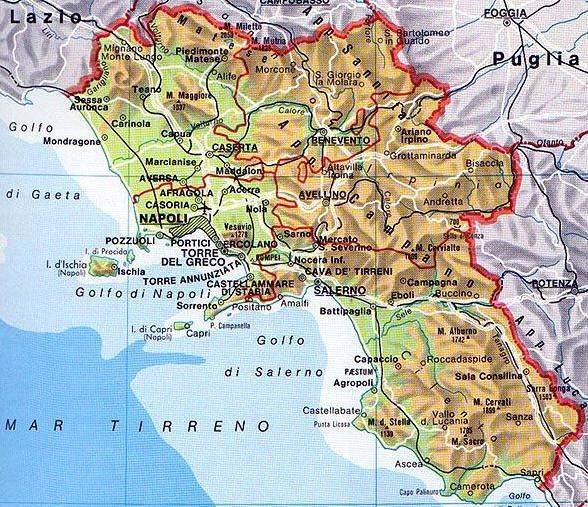
Campania's climate is one of the most favorable for human existence. The fertile plains near Naples and Salerno do not lack moisture. Therefore, in ancient times, this territory was often called the "Happy Campaign".
It is in this Italian province that Vesuvius can be seen. And here was the city of Capua (destroyed by vandals in 456), in the gladiatorial school of which the uprising of Spartacus began.
According to the most probable version, the word "camorra" comes from the name of the gambling game "morra", popular in ancient Rome. The meaning of this game was as follows: several people bent their fingers (or put away coins) and each of them had to guess in advance what the sum of the fingers or coins of all participants would equal. The winner received a "point", the game went up to three points.
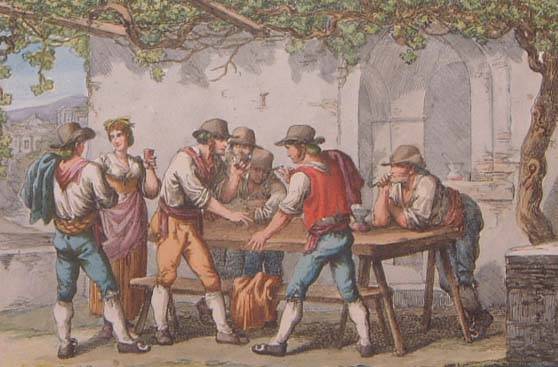
Bartolomeo Pinelli. Morra game, 1809
Often there were cases of cheating, when several people conspired to involve in the game and deceive some simpleton. They negotiated in advance about when and how many fingers each of them would bend, and distributed the answers, one of which was necessarily correct. Therefore, the word "morra" has become often used in the meaning of "gang", "gang". And "camorra", therefore - "to be with the gang" or "to be in the gang."
The emergence of the Camorra
The exact time of the Camorra's appearance in the Campaign is unknown.
Sometimes the birth of this criminal community goes back to the XIV century, which is hardly true. Others talk about the XNUMXth century.
Some believe that the Camorra originated at the same time as the Sicilian Cosa Nostra. However, the goals of these organizations turned out to be opposite: the mafia was allegedly originally a "patriotic" criminal organization, and the first Camorra, on the contrary, consisted of royal mercenaries recruited from Spain and terrorized Italian peasants (many Campanian aristocrats were also Spaniards).
Hence, by the way, another version of the formation of the name "Camorra" - from the old Spanish word "chamora" - the so-called short jacket, which was often worn by mercenaries in those parts. With the help of this hypothesis, they try to explain the centuries-old hostile relations between the Sicilian mafia and the Campanian Camorra.
And only after the Neapolitan Bourbons (the Spanish branch of this dynasty) came to power, another Camorra appeared in Campania - from the local poor.
The first written mentions of the "Camorra" appear only at the beginning of the XNUMXth century.
So, in 1820, the appearance in Naples of the Bella Societa Riformata society, also known as Societa Della Umirta, Annurataq Sugirta, “Respected Society”, was recorded. The Camorrists themselves called themselves
Contrary to this name, members of this society were by no means aristocrats, but people from the social lower classes.
Campanian notions of honor can be judged by the story that the bandit Zoto told the protagonist of Jan Potocki's adventure novel The Manuscript Found in Saragossa (first published in 1805).
Father Zoto, a native of the city of Benevento, located 54 km northeast of Naples, in response to the proposal of a jealous husband to kill his unfaithful wife for 150 sequins, says:
It’s immediately obvious that you don’t know me.
Yes, I attack people from around the corner or in the forest, as befits a decent person, but I never act as an executioner. "
And here is the result:
What act "added good reputation" to Zoto's father?
He took turns killing two aristocrats (the marquis and the count), each of whom paid him for the removal of the rival 500 zekhin. After that:
I am ready to guarantee that this case is still on the lips of everyone in Benevento. "
The novel also speaks of the authority enjoyed even by the "retired" "deserved bandits" of the Camorra.
Seriously wounded, Father Zoto asked for asylum in the Augustinian monastery, transferring all his savings to the monks. Seeing how, on the orders of a nobleman from the retinue of the Duchess de Rocca, his son was flogged with rods, he says:
The nobleman was forced to choose whose order he should carry out: the duchess or a suspicious crippled old man.
And he chose to obey the former bandit, since
However, most of the Campanian "people of honor" were not engaged in "big business", but in "small things": they taxed gambling houses and brothels, as well as small traders, "earned money" by smuggling.
That is why the "real" Sicilian mafiosi treated the Camorra with contempt, and Naples was called
This contempt by the members of Cosa Nostra for the people of Campania continued into the XNUMXth century.
The famous Alphonse (Al) Capone was a Neapolitan, which made it extremely difficult for him to reach the pinnacle of power in Chicago - he had to kill arrogant Sicilians, who presumptuously believed that only they had the right to be the donors of the "new" American mafia. This was discussed in the article "With a kind word and a pistol." Alphonse (Al) Capone in Chicago.
But the Sicilian Lucky Luciano finally saved the American Cosa Nostra from these prejudices, who took turns destroying two New York bosses of the "old school" - Giuseppe Masseria and Salvatore Maranzano. And along with them, those who did not think to run across to the winner in time. This was discussed in the article Mafia in New York.
Under the Bourbons in the Kingdom of the Two Sicilies, on the one hand, ordinary members of the Camorra were persecuted, but on the other, the authorities did not hesitate to use their services. For example, a certain Luigi Curzio, sentenced in 1839 to 12 years in prison for theft and smuggling, became a police informant who spied not on criminals, but on political opponents of the Bourbons. And even the aristocrats did not disdain ties with the authoritative leaders of the Camorra. Queen Maria Carolina, for example, did not hide her friendly feelings for Gaetano Mammon, one of the "bosses" of the Camorra, and even called him
When the last king of the Neapolitan Bourbon dynasty, Francis II, on the news of Giuseppe Garibaldi's movement to Naples, fled to Gaeta, the Camorrists controlled by Police Minister Liborio Romano on September 7, 1860 took over the protection of the "liberator of Italy" (who, at Romano's invitation, arrived here from Salerno by train) ...
At that time, the garrison of Naples was still loyal to the king. Had a strong and authoritative person found here, who decided to give the order for the arrest of Garibaldi, the career of this revolutionary could have ended in this city.
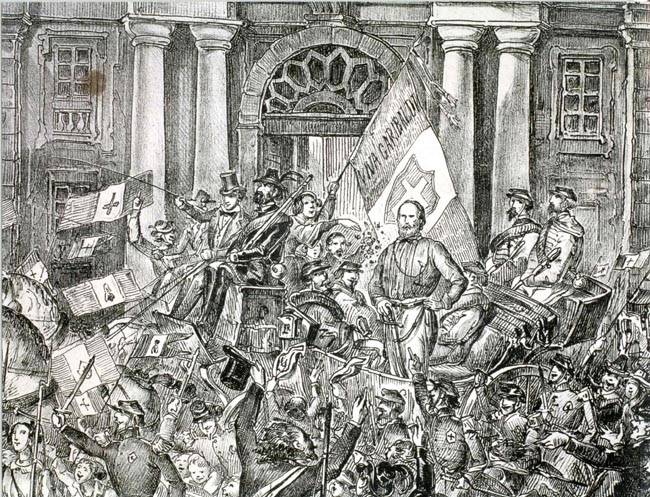
Francesco Wenzel. Garibaldi's entrance to Naples on September 7, 1860. Engraving
The "honeymoon" of the Camorra's idyllic relationship with the new government did not last long. The southern regions of Italy lagged far behind the northern regions in development, and the standard of living here was extremely low.
Plus, now Campania (and other southern provinces) was flooded with cheaper goods from Lombardy and other northern regions, which caused the ruin of many local businesses. In 1862, the uprising of workers in the Naples arsenal was suppressed by the new government, with dozens of people killed. Then anti-government peasant uprisings began in Campania. Many of these people who did not have any social prospects then joined the ranks of the "Respected Society".
The first serious trial of the Camorrists took place in 1911, when he was killed by the local bandit Cuokolo's accomplices for his collaboration with the police.
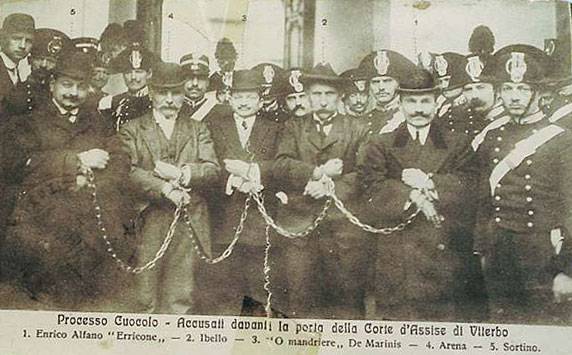
Photo from the trial of members of the Camorra, 1911
Unlike the classic Sicilian mafia, the Camorra was a loose conglomerate of different gangs, which sometimes could act in concert, but more often they competed with each other and sometimes there were "clan wars", which in Italy are called "faids". And therefore, after the conviction of the main ringleaders (27 people), this organization found itself in a deep crisis, having lost even the beginnings of centralized management. In May 1915, the dissolution of Bella Societa Riformata was announced.
During the campaign against mafia structures announced by Mussolini, investigators no longer found any signs of organized crime in the Campaign: ordinary, unrelated gangs of criminals were operating in Naples and its environs. And the Duce announced a complete victory over the Camorra.
A new breath of the Camorre opened a collaboration with the famous boss of New York's Cosa Nostra Lucky Luciano, who was exiled from the United States to Italy in 1946. He decided to make Naples a transshipment base for smuggling cigarettes, and along with drugs.
Lucky's "business partner" was former New Orleans boss Silvestro Carollo, nicknamed "Silver Dollar Sam", also exiled from the United States in 1947. It was he who managed to defend his city from the encroachments of Al Capone himself, as described in the article Mafia in the USA. Black Hand in New Orleans and Chicago.
It was cooperation with the Sicilians that contributed to the birth of a new and already truly formidable Camorra.
Modern Camorra
Occupying only the third place in influence among the four criminal communities in Italy, Camorra is now the most "bloody" of them: the bosses of the Mafia and, especially, the Ndranghets in recent years have been striving to look not like traditional "Don" and "godfathers", but respectable businessmen. As you know, big money "loves silence", and therefore the leaders of the Sicilian and Calabrian clans try not to attract the attention of the authorities.
They are reluctant to go to "wet business" - only in the most extreme cases. Excesses like the famous execution of members of one of the Calabrian "families" in Duisburg (this will be discussed in the article on Ndragnet) are, rather, an exception to the rule. Camorrists, on the other hand, don't usually think when pulling the trigger.
It is curious that, as in the Sicilian mafia, in Camorra there is a ritual associated with kissing: a kiss on the lips means a promise to be silent during the investigation.

Kiss of the arrested Camorrists, photo by Der Spiegel magazine
But in the mafia, a kiss on the lips is a death sentence. Let us recall at the same time that a kiss on the cheek in the Sicilian tradition is a promise to treat as an equal, and a kiss of the hand is a recognition of a subordinate position.
Scottish historian John Dickey, author of The History of the Mafia, said in an interview that the Camorra is still
It is a formless conglomeration of various groups, some of which are just small gangs of drug dealers, while others have great power to influence politics and the economy.
In Naples and its environs, the Camorra is now a kind of proletarian crime. "
Roberto Saviano, author of the investigative book Gomorrah, said in an interview:
Other researchers call the modern Camorra
The lowest level is occupied by spontaneously forming youth gangs, such as our "Lyuber" at the end of the 80s.
They serve as a personnel reserve for more serious "brigades" that "hunt" in the rich "bourgeois" areas, where they usually distribute drugs.
Camorrists of these gangs usually do not commit crimes in the quarters of their base, on the contrary, they make sure that the young, as they say, "see the edges" and especially not limitless.
These "brigades" are under the control of the big bosses of the Camorra, who themselves, of course, do not participate in the criminal showdown. Ordinary Camorrists and their “brigadiers” “work on the ground”, carrying out various orders of their bosses, including, if necessary, waging wars with bands of opposing clans.
And finally, at the top of this pyramid are top-level structures that do really big things - from participating in international drug trafficking to investing in real estate and legal businesses throughout Italy and abroad. One such boss was, for example, Gennaro Licciardi, who co-founded Alleanza di Secondigliano.

Arrested by Gennaro Licciardi, 2 August 1992
This Alliance united 6 families, up to 20 gangs were subordinate to it in Secondigliano and other suburbs of Naples. Later, Alleanza di Secondigliano was headed by Gennaro's sister Maria, which will be discussed in the next article.
John Dickey, quoted by us, also argues that, in comparison with other criminal communities in Italy, the Camorra is
This is also quite understandable, given the not at all "patrician" origin of most of the members of this community.
Roberto Saviano, mentioned by us, said about the Camorrists in an interview (2006):
The "godmother" Immacolata Capone, shot two years ago, dressed exactly like Uma Thurman. "
We will talk about this lady (and many others) in the article "Women of the Camorra".
For now, let's continue to quote Saviano:
During the shooting, he is held obliquely, like the guys from "Pulp Fiction" ...
When the son of one of the bosses of the Camorra, Cosimo di Lauro, was arrested, the children shouted:
"Raven, raven"!
The thing is, Di Lauro was dressed exactly like Brandon Lee in The Raven (as a rock star reborn from the dead). "
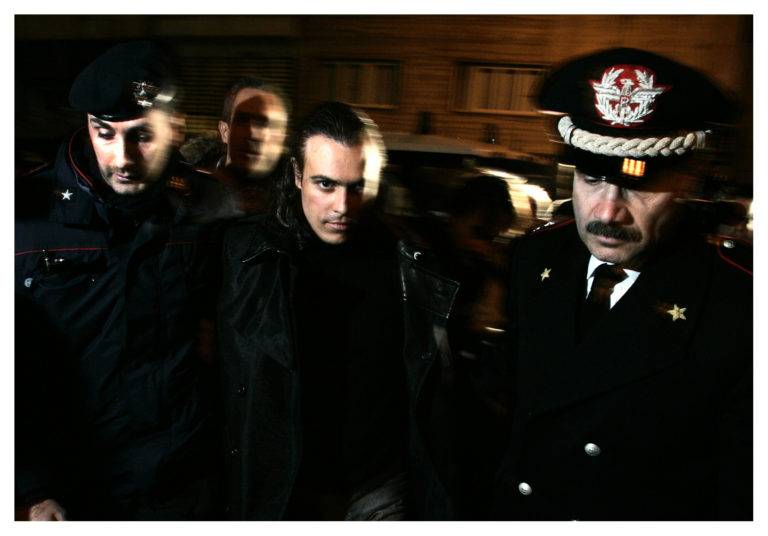
Arresto Cosimo Di Lauro
In the book Gomorrah, Roberto Saviano describes his arrest as follows:
He stood in front of the mirror, moistened a comb, combed back the hair from his forehead and gathered it in a ponytail at the back of his head, leaving a few strands to lie around his neck.
He was dressed in a dark turtleneck and a black cloak.
Cosimo Di Lauro looked comical in a gangster style, in the style of a night killer, and descended the stairs with his head held high. "
And here is what followed his arrest:
This group hysteria is not needed to derail the arrest, as it might seem, but to prevent vendetta. To avoid even a shadow of suspicion.
This is a sign for Cosimo that he was not betrayed. Nobody betrayed him, it was not the neighbors who discovered the secret hideout.
This large-scale event is a kind of prayer for forgiveness, a service in the name of atonement for sins, where the sacrificial altar is built of smoldering police cars and overturned dumpsters, over which hangs black smog from burning tires.
If Cosimo suspects something, then they will not even have time to collect their things: they will face another merciless punishment - the wrath of his comrades-in-arms. "
(Roberto Saviano. "Gomorrah").
It is curious that many wealthy Camorrists, hung with gold chains and driving prestigious cars, remain to live in poor quarters of Naples: moving to "bourgeois" areas is considered "bad form", and "associates" can get it "wrong." "Not by concept", in general.
Modern camorrists are passionate about football.
The bosses of one of the Neapolitan Camorra clans patronized Diego Maradona when he was the attacker of the local club "Napoli" (incidentally, "hooked" him on cocaine). It was suggested that half of the money for the transfer of this Argentinean was allocated by Camorra (the contract of 14 billion lire was a record for Serie A, and was clearly beyond the means of the hopeless middle peasant Napoli).
And the Casalesi clan, through dummies, tried to buy Lazio in 2008.
But we will talk about this in the next article - "New structures of the Camorra and Sacra Corona Unita". It will tell about the "New Family" and "New Organization of the Camorra", as well as - about the Apulian criminal community Sacra corona unita, in the organization of which had a hand in Rafaelo Cutolo, the creator of Nuova Camorra Organizzata.
And then we'll talk about the women of the Camorra.
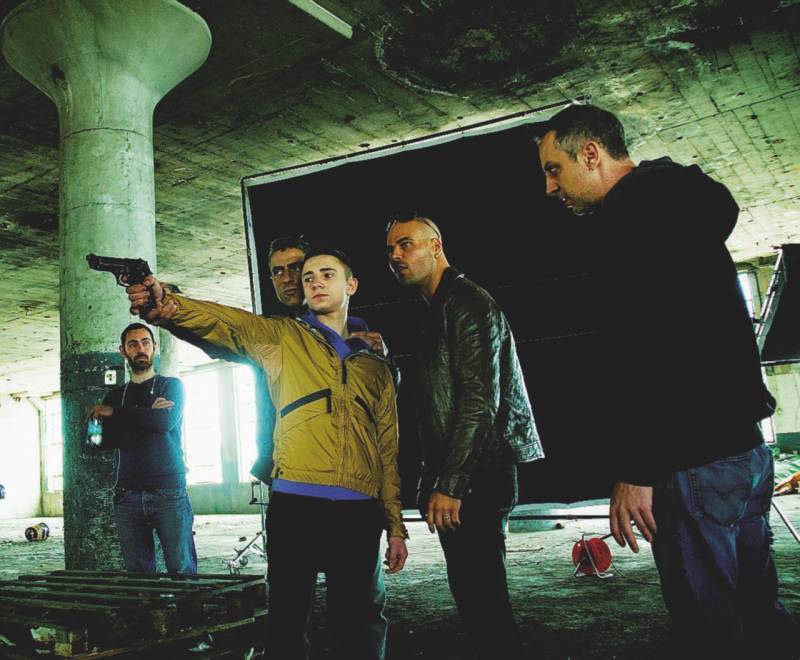
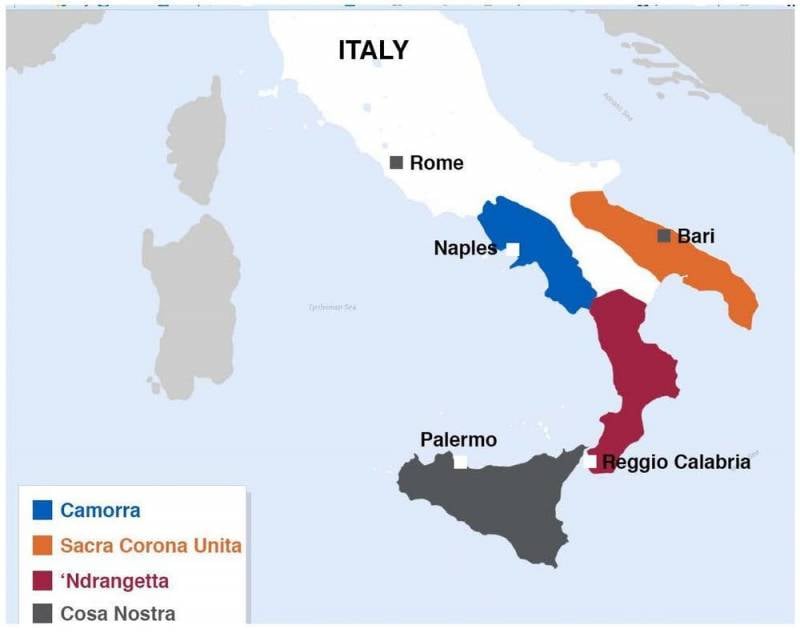
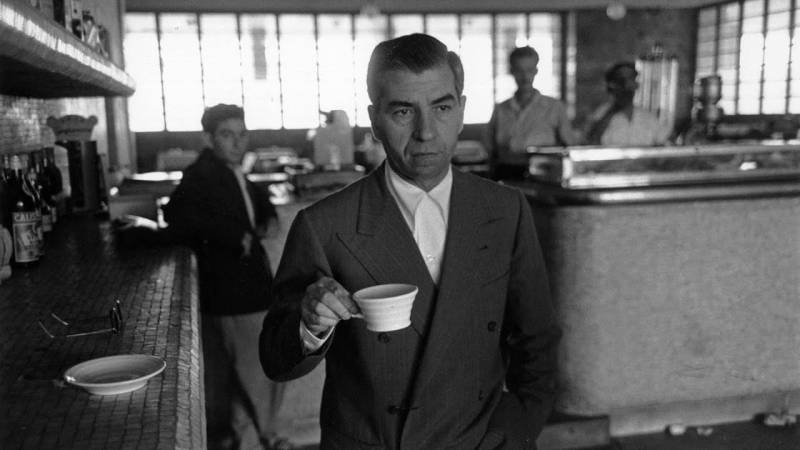

Information